NIGHT VISION GOGGLES [VISUAL BUYING GUIDE]

Best Bang For Your Buck
Best Bang For Your Buck

Best of the Best
Best Bang For Your Buck
Best Bang For Your Buck

New & Innovative

PVS-14 MONOCULAR

BNVD’S (MILSPEC STYLE) NIGHT VISION BINOCULARS

L-3 GPNVG-18

CIVILIAN STYLE MONOCULARS

CIVILIAN STYLE NIGHT VISION BINOCULARS

AN/PSQ-20B ENVG
BOTTOM LINE
PVS-14's have been the workhorse of the US military over the course of the last 10 years. They are versatile, light, and relatively inexpensive. They may also be mounted on a weapon system. Prices will vary by manufacturer, and tube type/generation.
Night Vision Goggles/Binoculars are going to provide the user with a reasonable FOV, the most common BNVD's go by military nomenclature (PVS-15, 21, 23, 31) with small and large differences between all of them. With pricing affected by manufacturer and tube type/generation.
If you are looking for the very best in field of view (FOV), 97 degrees to be exact, and cost isn't an option these should be the first thing you look at. Depth perception is improved, and the two outside tubes increase peripheral vision.
Similar in the single tube design of PVS-14's, these civilian style monoculars come from various manufacturers and are more geared towards recreational use using less expensive tubes and designs. These are well suited for your next camping trip, or for fun home use.
Much like the civilian style monos, these binos come in tons of options for tube type, and of course price. With the majority in the GEN 1&2 range and most between 500-2000 dollars. Some of the better options would work ok for surveillance and hunting as some do offer additional magnification.
What's better than night vision? Thermal imaging combined with it. L3's innovation with combining the two is a game changer. The user receives a fused together image with three different modes; thermal overlay, thermal outline, and full thermal.
PROS
Price range makes these more affordable for individuals and police departments looking for night vision. Plenty of options and manufacturers offering quality PVS-14 style night vision monoculars for police work, hunting, etc. Capable of being extremely lightweight.
With so many options when it comes to Night Vision Goggles/Binoculars, you should be able to find something that fits your budget and specific needs. Gen3 tubes, in light-weight housings with auto gain and other premium features you will pay for but are typically worth it.
Top of the line Gen3 US L3 tubes are utilized providing unparalleled FOV with 4 separate units. Modular design for maintenance and supportability in a ruggedized housing to meet the extreme requirements of tactical ground use.
Pricing is very reasonable for these units, for what you recieve considering 10-15 years ago these units would have been in the thousands. Lightweight, and easy to use. The ones we tested had a decent battery life and came from reputable optic companies.
Much less than the MILSPEC style versions for night vision goggles in terms of price. Styles sporting higher generation tubes have decent clarity and are easy to use. Would work fine for the average hunter who just wants to see at night.
Combination of thermal and image intensifier night vision providing additional detectability of possible threats from heat sources that normal night vision may have missed due to camouflage, foul weather, limited light source, or other obscurants.
CONS
Limited FOV with only one tube. Users may notice increased eye fatigue if constantly switching between the night vision device and the naked eye.
BNVD's are harder to switch between NVD and naked eye use. Most are based on MILSPEC specifications which will bring up the price.
The current price point will put these out of the reach of even the best funded. Slightly heavier than other options.
Almost all of the ones we tested used GEN1 tubes, which leaves much to be desired when you are using GEN3 + tubes to compare. Wouldn't be ideal for police, military, or the serious hog hunter.
The ones we tested were mostly designed to be used for hand-held use like normal binos are. Headborne mounting options were really limited. Heaviest units we tested.
Like the GPNVG's the price for these are going to be out of reach for most users. The thermal housing adds a good amount of weight as well.
TESTING DATA
GENERATION: GEN’s 1,2,3
BATTERY LIFE: Approx. 50 Hours
RESOLUTION: 57-72 lp/mm
FOV: 40°
WEIGHT: 8-14 oz
FOCUS: 8-18 in to Infinity
*Generalizations
GENERATION: GEN’s 2,3
BATTERY LIFE: 10-30 Hours
RESOLUTION: 57-64 lp/mm
FOV: 40°
WEIGHT: 8-22 oz
FOCUS: 8-18 in to Infinity
*Generalizations
GENERATION: Gen3 U.S. L-3
BATTERY LIFE: Approx. 30 Hours
RESOLUTION: 64 lp/mm
FOV: 97°
WEIGHT: 27.0 oz
FOCUS: 18in to Infinity
GENERATION: GEN 1 (few 2's)
BATTERY LIFE: 6-40 Hours
RESOLUTION: 24-42 lp/mm
FOV: 35-40°
WEIGHT: 10-22 oz
FOCUS: 18in to Infinity
*Generalizations
GENERATION: GEN 1 (few 2's)
BATTERY LIFE: 6-40 Hours
RESOLUTION: 24-54 lp/mm
FOV: 40°
WEIGHT: 22-61 oz
FOCUS: 10-18in to Infinity
*Generalizations
GENERATION: Gen3 U.S. L-3
BATTERY LIFE: 8.5 Hours of Fused
RESOLUTION: 64-72 lp/mm
FOV: 40° (25° Diagonal, Thermal)
WEIGHT: 32.0 oz
FOCUS: 9.8 in to Infinity
The Ultimate Night Vision Mounting System Buyer’s Guide
HOW DID WE MAKE OUR DECISIONS?
Each mounting system tested was purchased or borrowed; we never accept anything from product manufactures. By keeping our reviews independent, we can ensure you that our reviews are unbiased. You deserve nothing less. We are a group of formal combat veterans with lifetimes of experience working with the lights out and draw many of our comments about these systems from that experience.
We tested all 5 models discussed, interviewed 12 industry experts, and read over 1000 customer reviews.
How We Decided
Each night vision device tested was purchased or borrowed, we never accept anything from product manufacturers.

16
Models Tested

12
Experts Interviewed

62
Consumer Reviews
We are lucky to have a team made up of numerous special operations personnel and police with lifetimes accumulated under NVG's. We kept this review as unbiased as possible and relied on their input heavily. The research conducted to analyze and compare these night vision optics was in depth and based not only off initial impressions and hard data, but also on consumer reviews and other industry experts.
Bonus: With the purchase of any HHV helmet comes significant discounts on night vision through our partner suppliers! Up to $1500 off!
Night Vision Generations dictate price, clarity, brightness, and longevity. You will typically see them labeled as GEN 1-4. The US military after analyzing GEN 4 technology decided that it was still just slightly improved GEN 3. Therefore you will still see some companies marketing GEN 4, or 3+, but for simplicity, we will stick with the US military and use 1-3.
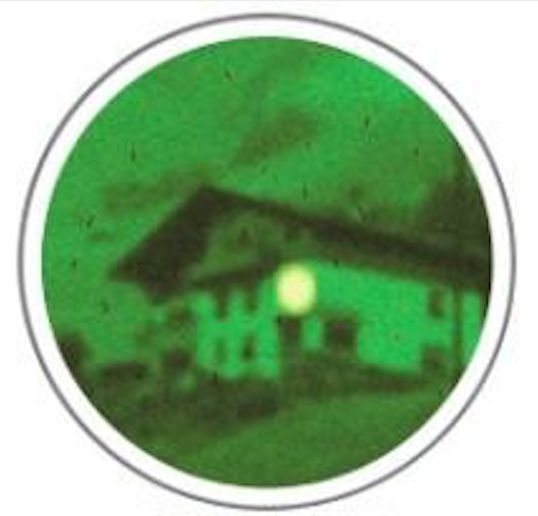
GEN 1
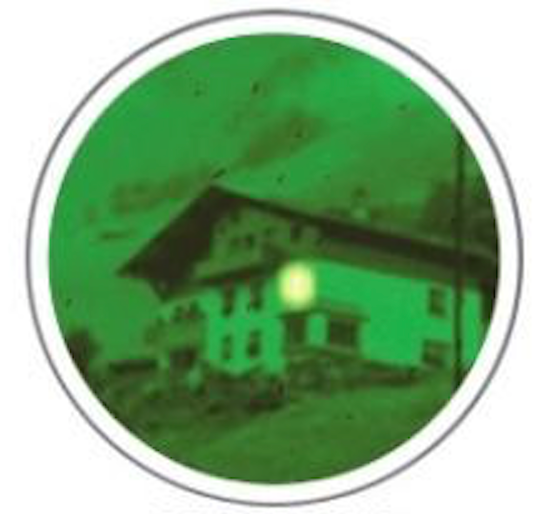
GEN 2
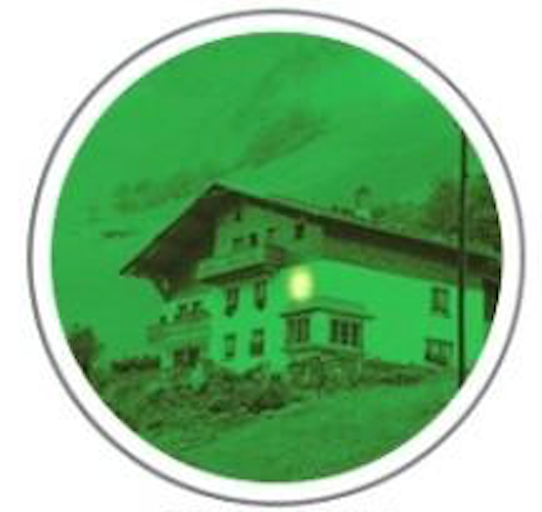
GEN 3
Generation 1 night vision has been around since the 1960s and used in the Vietnam war. At the time it was certainly better than nothing, but as you can see from the photo above, as the generations progressed, so did the clarity, and price as well. Another thing worth nothing is there are different degrees of quality for each generation. The US military gets first picks on the best tubes coming off the production line. This is why you will sometimes see quality differences between two of the exact same generation tubes, and even models.
Night vision technology has evolved over the years, with several generations of devices being developed to improve performance and functionality.
Generation 1: The first generation of night vision devices used an image intensifier tube to amplify available light and provide a clear image in low-light conditions. These devices were relatively bulky, had limited resolution, and were often prone to image distortion.
Generation 2: The second generation of night vision devices improved upon the image intensifier tube technology used in generation 1 devices, resulting in better image quality and resolution. Generation 2 devices also had improved resistance to bright light exposure, making them more versatile and usable in a wider range of lighting conditions.
Generation 3: The third generation of night vision devices saw the introduction of multi-alkali photocathodes, which improved the performance of the image intensifier tube and provided better resolution and image quality. Generation 3 devices also had longer battery life, making them more practical for extended use.
Generation 4: The fourth generation of night vision devices combined image intensification technology with thermal imaging to provide users with the ability to see in complete darkness. These devices were compact, lightweight, and offered improved target acquisition and situational awareness in low-light conditions.
Each generation of night vision technology has built upon the previous generation to provide increasingly advanced capabilities and improved performance. The current state-of-the-art in night vision technology continues to evolve, offering soldiers, law enforcement, and other users improved situational awareness and target acquisition capabilities in low-light conditions.
PRODUCT IN DEPTH
L-3 GPNVG-18
Design Difference
97 degrees of horizontal field-of-view that allows for observation and/or target identification in low-light conditions and is ruggedized for ground applications. Individual monoculars can be detached from the system and powered with the included power adapter to provide a low-profile handheld night vision monocular.
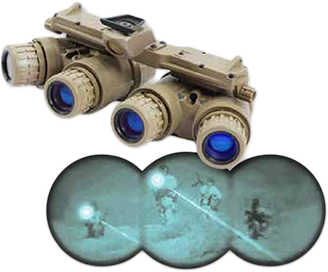
HOW DO NIGHT VISION GOGGLES WORK?
By Boosting Light
Unlike nocturnal animals who have larger than average pupils, and what's called tapetum that reflects light, similar to a mirror, humans have to rely on technology and power in order to see through the darkness. We do this by turning the light into electricity, boosting that electricity, and then turning the boosted electricity back into light!
Here are the Steps:
Light from the moon, stars, or other sources enters the lens at the front. The light is made of photons (particles of light) of all colors.
As the photons enter, they strike a light-sensitive surface called a photocathode. The photocathode converts photons into electrons.
Electrons are amplified by a photomultiplier. Each electron entering the photomultiplier has many more electrons leaving it.
The electrons leaving the photomultiplier hit a phosphor screen, creating tiny flashes of light.
With the increased photons than what originally entered the night vision goggles, the screen results in a brighter version of the original scene.
PRODUCT IN DEPTH
PVS-14 Night Vision Monocular
Features
PVS-14's are one of the most versatile monocular platforms on the market. The majority of all companies with night vision goggles for sale or goggle, in this case, will have a version of PVS-14's. They are capable of being used on a weapon system, bridged into a pair, and with just about any feature you want.
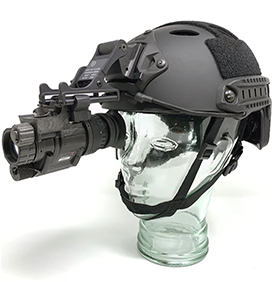
NIGHT VISION IMAGE-INTENSIFICATION TUBES
Where The Magic Happens
Night Vision housings are relatively inexpensive to produce, but the image intensification tubes that are in them is where the prices start to climb. Only a handful of companies manufacture them, and even less high-quality ones.
Typical material types include foams, rubbers, plastics, and hybrid options.
The most recognized companies producing high-quality tubes are L-3, Harris, and Photonis. Each offering a wide variety of different generations and options. If you are looking for the best, stick with tubes from these companies.
We have seen a select few night vision tubes being created overseas with some success. It will most likely only be a matter of time before quality tubes made outside of the US become available.
Image Intensification tubes from companies are then sold to other manufacturers that will put them into their own night vision housings with varying features and designs. Companies such as L-3 make their own housings as well but typically will only sell direct to government entities.
NIGHT VISION FEATURE CONSIDERATIONS
Autogated And Gain Adjustment
Auto-Gating works to improve the night vision image displayed during dynamic lighting conditions, think muzzle flashes, oncoming traffic, or sudden white light usage. It also helps with the transition from low-light into night.
Auto-Gating tubes are typically only found in GEN3 tubes, and it also helps protect the tubes itself from direct light exposure that can damage them. The video below provides a visual reference of what auto-gating does.
Manual Gain Adjustment allows the user to change the brightness of the image displayed. This is especially helpful, to get the best image possible with changing environments such as a night with 0% illumination from the moon and stars vs one with 100% illum.
PRODUCT IN DEPTH
Civilian Style Night Vision Monoculars
Recreation & Hunting
If you don't want to break the bank and aren't relying on the device with your life these civilian style NVG mono's are pretty good. Typically using a GEN1 tube and under $400. Things like clarity, resolution, eye relief, etc were lacking, but we would say that's to be expected.
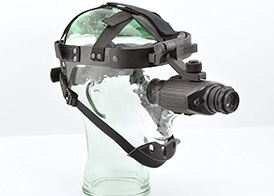
Did You Know?
Two different phosphor types are normally offered with tubes, the normal green, called P43 green phosphor and white called P45 white phosphor.
Generally, the white is going to give better shadowing and overall image for most users, but will also cost more. If you'd like to learn more about the different types of Phosphor used in Night Vision manufacturing, check out this blog post.
Is Night Vision Legal?
Yes, it is, in the United States you can own any generation of night vision!
Where you can get in trouble though is if you ever try to take it out of the United States. Most are ITAR controlled and require the proper licensing to export.
ADDITIONAL NVG FEATURE CONSIDERATIONS
(IR) Illuminators, Power, Battery Life, And Magnification
IR Illuminators on night vision devices help in those extreme low light conditions. Infra-Red (IR) Illuminators emit light that is nearly invisible to the naked eye, thus acting as a flashlight of sorts for your NVG's when there isn't enough other light to provide a proper image.
Power source and the life of that source are important features to consider as well. The majority of night vision use standard batteries such as AA's, but you will also find dedicated battery packs and other power sources.
Magnification is another feature that depends on your own needs. The majority of night vision goggles are going to be 1X as you wouldn't want to be trying to wander around at 10X magnification. Some are used however from a static position, and the magnification is then very helpful.
NIGHT VISION MOUNTING OPTIONS
Night Vision Helmet, Skull Mount Face Mounts, Handheld, Tripods
The most common way to use night vision is to have it mounted to your head somehow. This allows for hands-free use. The most common options are a ballistic helmet such as our ATE ballistic, or a non-ballistic helmet like our ATE Tactical Bump helmet. Most helmets consist of a shroud that receives the NVG mount of your choice, that then connects to the night vision goggles themselves.
Other head-mounted options include "skull" or “face” mounts that are similar to a helmet type retention system, but with only the shroud and no actual helmet shell. We typically prefer a bump helmet over these options as you get so much more comfort and protection at the cost of only a few extra ounces.
Night vision goggles and monoculars are also easily used as handheld units or mounted to a tripod as well. These types of setups are ideal for when you don't need to be mobile or require the use of your hands.
PRODUCT IN DEPTH
AN/PSQ-20B ENVG
Night Vision & Thermal
Night Vision on its own does have drawbacks, such as obscurants such as smoke, or camouflaging that makes threat identification difficult. Enter thermal night vision which combines that image with a thermal one. You now have a tool that provides unparalleled situational awareness. AN/PSQ-20B ENVG's are now being fielded by the US Army as the next standard issue NVG for ground troops.
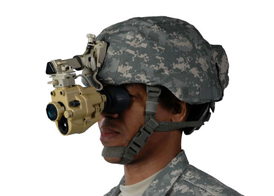
DIGITAL NIGHT VISION
Another technology that is improving and evolving quickly is digital night vision. While it's been around for a long time, think older camcorders or security cameras several companies have started producing scopes and helmet-mounted units that provide pretty good results for much less than standard night vision that utilizes intensifier tubes. One company in particular is SIONYX. We have used their AURORA BLACK for filming needs and while not on par with with the capabilities of intensifier tube NVG's it works really well! How it works is digital night vision changes the image you see to an electric signal which is then channeled to an image sensor. In terms of image quality, we would place the current technology on par with GEN 1-2 night vision devices. As this technology improves though we see digital night vision as a very viable option for hunting and even tactical use.
PRODUCT IN DEPTH
BNVD Night Vision Goggles Military Style
Design Difference
This style of night vision has been the choice for most Special Operations units around the world for the past 10 years. Most will allow for single or dual tube usage, featuring GEN3 tubes, with autogating and manual gain options. Most night vision companies will have a few "MILSPEC" style BNVD's for you to choose from.
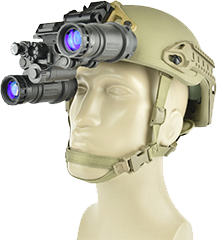
HOW MUCH SHOULD I PAY FOR A NIGHT VISION?
It depends on your needs and usage. Night vision binoculars price can be between $400 on the low end and up to $40,000 on the high-end. If you are a police department or relying on the night vision for any type of work we suggest purchasing the best night vision that you can.
For military night vision systems, or close to "MILSPEC" expect to pay between $3000-$5500 for a good mono set up, and upwards of $13,000 for a high-quality BNVD.
On the civilian style of night vision goggles expect to pay anywhere between $400 to $6000, again depending on tube generation and features.
TIPS, TRICKS AND BUYING MISTAKES
One of the biggest mistakes people make is not buying from a reputable company. Sure you can get them slightly cheaper from the part-time business that builds them in their garage but... Are they using high-quality tubes or second hand blemished ones? Do they offer an extensive warranty? How's their customer service?
Another mistake is not buying the correct generation for your needs. There is a big difference between GEN1 and GEN3 tubes, and really the best way to tell is to see it in person if you can.
Quick Tip: A few night vision companies have started night vision rental programs. This is a great way to try out different types before making your own investment.
Quick Tip: Are things out of focus when looking through the tube? Most NVG's allow the user, much like on normal optics to adjust the focus. Along with how close they will focus. Check out your manual if you have questions.
Quick Tip: Working in a bright night-time environment? The rubber cap that most night vision comes with to protect the lens can be installed and a small pen hole or X cut into the center. This will reduce the amount of light flowing through, decreasing the brightness. Some companies even include pre-cut caps.
TRAINING WITH NIGHT VISION
Once you spend the money for your night vision setup it's like any other piece of equipment. You have to train with it! Some important training considerations are as follows!
Are your optics NVG compatible?
Will you be using an infrared laser on your weapon system? You will need to learn how to zero and safely use this as well.
Normal movement while using NVG's. Even normal walking can be much more difficult under nods.
Common weapons drills such as reloads, malfunctions, transitions, moving and shooting all must be practiced.
Integration of white light, when to look under your nvg's and use white light vs only using your nvgs.
Use with other gear such as CBRN, comms, etc.
Mobility training such as driving.
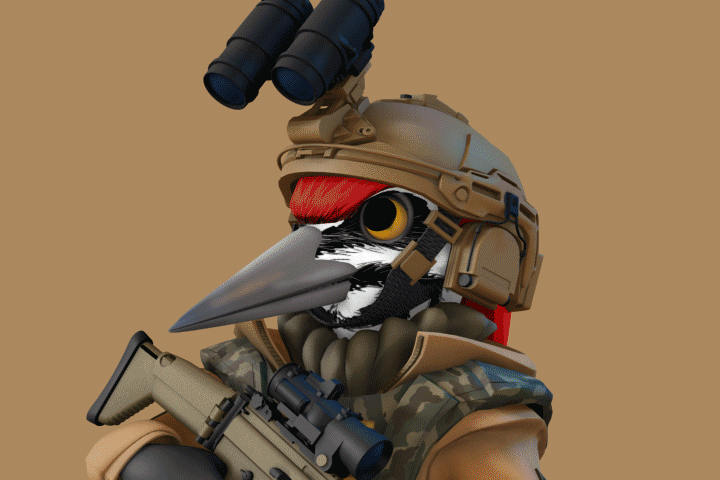
NIGHT VISION ACCESSORIES
When it comes to night vision accessories there is no shortage of items that when used in tandem with your night vision device can increase its overall utility.
IR LASERS AND VISIBLE LASERS
Arguably one of the most important pieces of equipment if using a weapon system with your night vision optics is an infrared and even visible laser. Such as a PEQ-15 or dbal. These lasers deserve their own guide so we won't get into them in-depth here, but it will most likely be something you purchase at the same time as your NVG's or soon after.
WHERE TO BUY NIGHT VISION
Having used numerous systems, generations, and companies we would highly recommend checking out Armasight. They have just about every type of night vision system for sale, and if you have purchased a helmet from us you also can get up $1500 off/10% when purchasing from them.
IR FLASHLIGHTS AND OTHER IR LIGHTS
We talked about built-in IR illuminators, but an additional light source in infrared can mean a world of difference, especially in low illum situations. These can be weapon-mounted lights, handheld versions, and even specialty IR lights found on most military vehicles. Companies such as Surefire or Inforce make dual white light and IR models, or you can sometimes get an IR lens/cover for some lights.
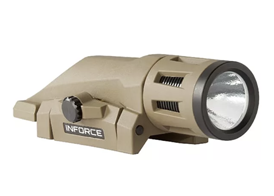
NIGHT VISION SCOPE ATTACHMENT
One of the big pros of purchasing a monocular, such as a PVS-14 is that you can actually mount it in tandem with a rifle optic. This night vision scope mount sometimes referred to as clip-on night vision allows the user to use the monocular either mounted to their head or to a rifle. The rifle mount will sometimes require some type of night vision scope adapter. We really like the PVS-14 QD Pivot Mount (shown in photo) from LaRule Tactical for the PVS-14 we have.
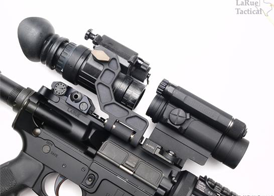
NIGHT VISION FOCUSING DEVICE
If you have ever used night vision, or once you do, you are going to realize that you have to adjust the focus manually depending on what distance you are looking at things. This can be an issue if you need to see something close and then quickly go back to normal viewing distances. The Tarsier Eclipse ™ from MATBOCK solves this issue. "allowing the operator to see objects from 18" to infinity at the same time and without loss of clarity." You can also make them yourself! Check out this great video from Kinetic Consulting. (YouTube)
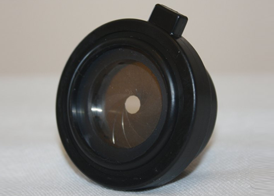
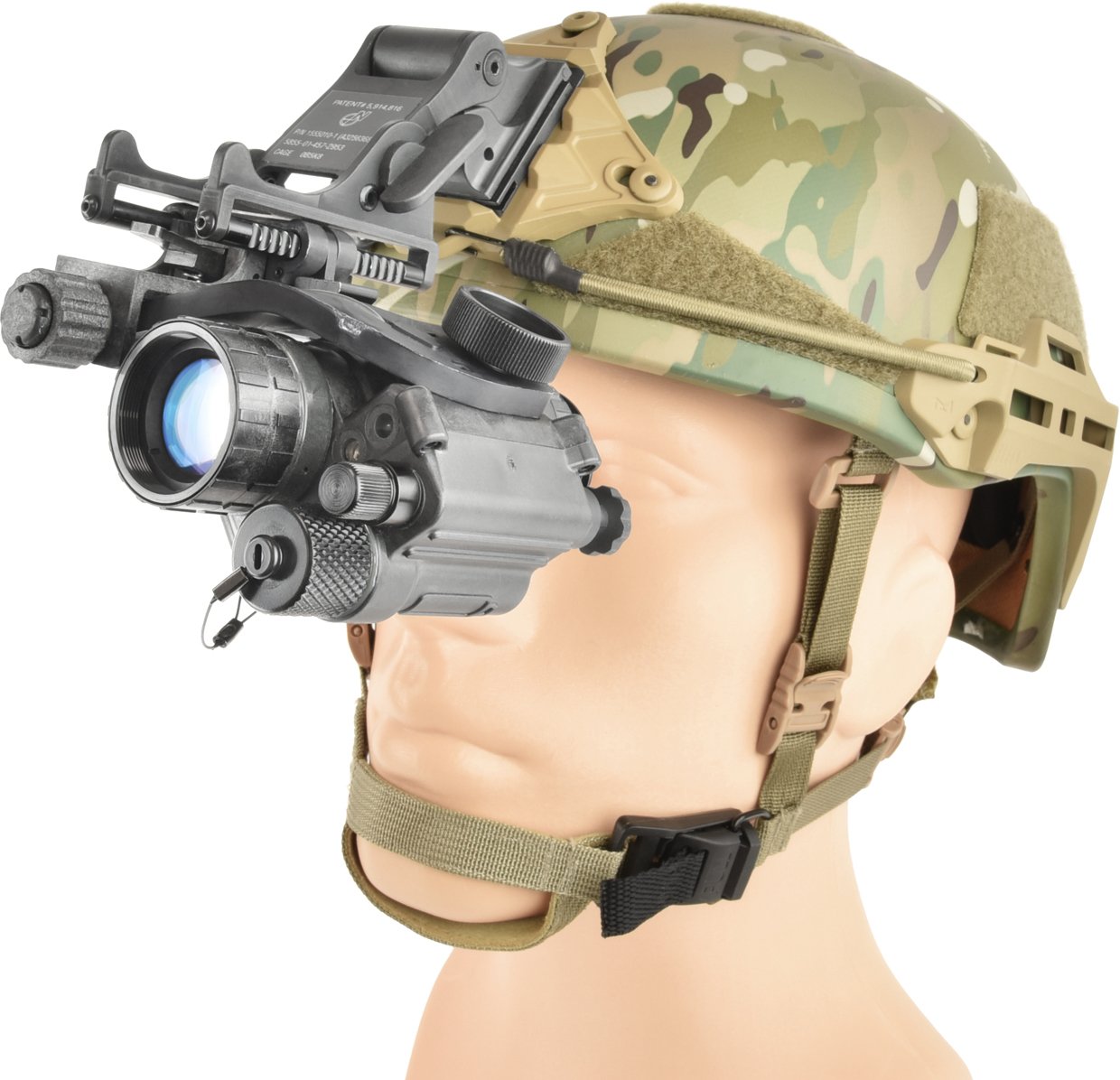
PVS-14
The PVS-14 Night Vision Monocular is the current military issue night vision goggle for the US armed forces. It is also the preferred choice of many foreign (NATO) forces. Produced by the hundreds of thousands, the 14 will continue to march on for many years to come.
The PVS-14 is the all-around best multi-functional night vision monocular available. Head or helmet mounted; the PVS-14 allows the user to retain their night adapted vision in one eye while viewing their surroundings through the illuminated eyepiece of the PVS-14. The new battery housing completes the perfect package by allowing the user to power off the unit when in an upright position and power on when flipped down.
Another strength is its ability to be weapon mounted behind most collimated daylight aimers and Reflex sights such as the ACOG, Aimpoint and EO Tech systems. This allows the user the ability to use their PVS-14 both as a night vision monocular for increased mobility and tactical awareness and as a short-range weapon sight.
Gain control gives the user the ability to increase or decrease the tube gain. Under extremely dark conditions, gain control allows the user to adjust the gain upward, giving a better image. Under high light conditions, details can be washed out due to an excess of light. Lowering the system gain can allow those details to be better seen. Additional features of the PVS-14 include an infrared LED with LED indicator and a low battery indicator.
The PVS-14 Night Vision Monocular is the current military issue night vision goggle for the US armed forces. It is also the preferred choice of many foreign (NATO) forces. Produced by the hundreds of thousands, the 14 will continue to march on for many years to come.
The PVS-14 is the all-around best multi-functional night vision monocular available. Head or helmet mounted; the PVS-14 allows the user to retain their night adapted vision in one eye while viewing their surroundings through the illuminated eyepiece of the PVS-14. The new battery housing completes the perfect package by allowing the user to power off the unit when in an upright position and power on when flipped down.
Another strength is its ability to be weapon mounted behind most collimated daylight aimers and Reflex sights such as the ACOG, Aimpoint and EO Tech systems. This allows the user the ability to use their PVS-14 both as a night vision monocular for increased mobility and tactical awareness and as a short-range weapon sight.
Gain control gives the user the ability to increase or decrease the tube gain. Under extremely dark conditions, gain control allows the user to adjust the gain upward, giving a better image. Under high light conditions, details can be washed out due to an excess of light. Lowering the system gain can allow those details to be better seen. Additional features of the PVS-14 include an infrared LED with LED indicator and a low battery indicator.
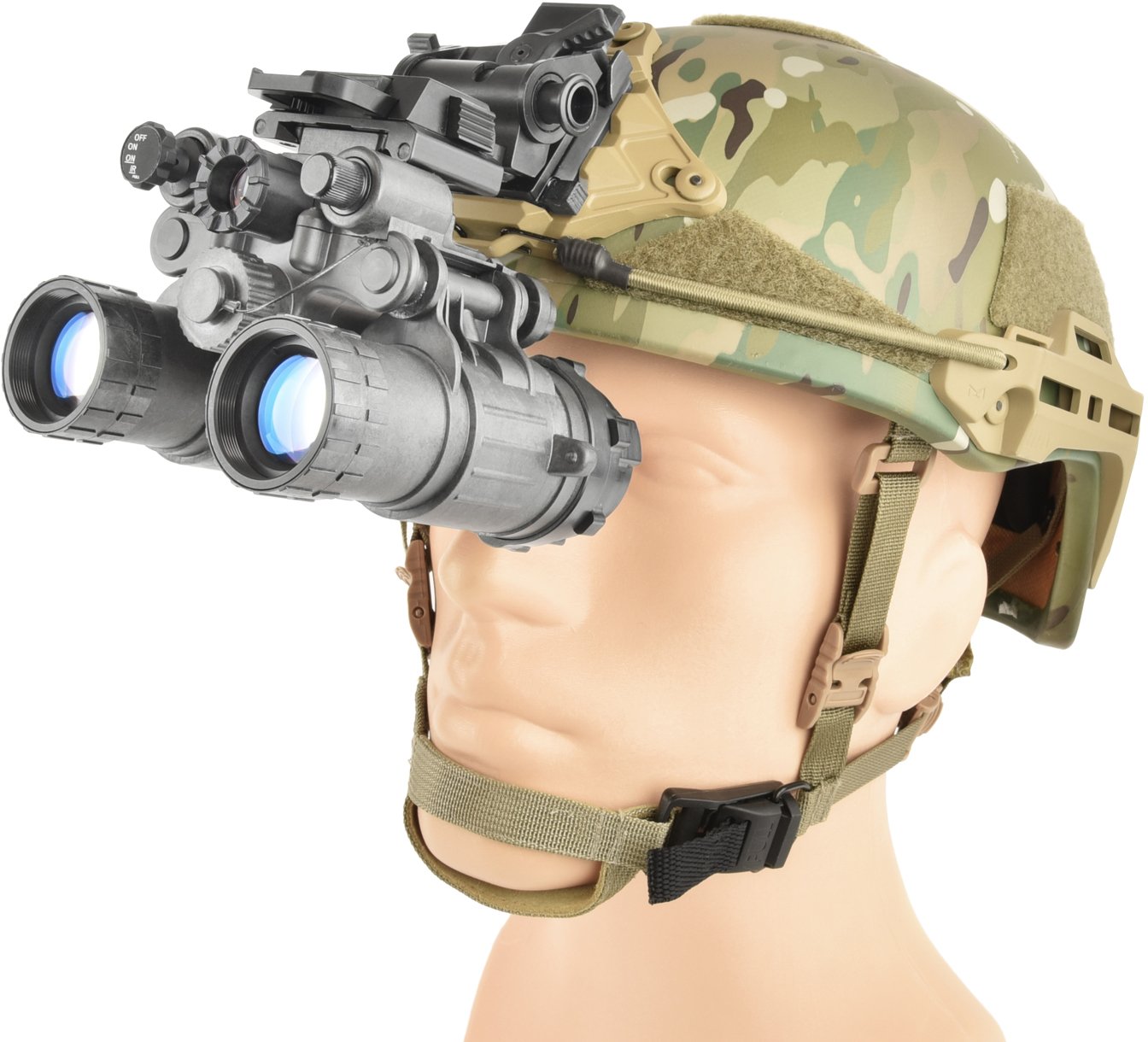
BNVD
The PVS-14 Night Vision Monocular is the current military issue night vision goggle for the US armed forces. It is also the preferred choice of many foreign (NATO) forces. Produced by the hundreds of thousands, the 14 will continue to march on for many years to come.
The PVS-14 is the all-around best multi-functional night vision monocular available. Head or helmet mounted; the PVS-14 allows the user to retain their night adapted vision in one eye while viewing their surroundings through the illuminated eyepiece of the PVS-14. The new battery housing completes the perfect package by allowing the user to power off the unit when in an upright position and power on when flipped down.
Another strength is its ability to be weapon mounted behind most collimated daylight aimers and Reflex sights such as the ACOG, Aimpoint and EO Tech systems. This allows the user the ability to use their PVS-14 both as a night vision monocular for increased mobility and tactical awareness and as a short-range weapon sight.
Gain control gives the user the ability to increase or decrease the tube gain. Under extremely dark conditions, gain control allows the user to adjust the gain upward, giving a better image. Under high light conditions, details can be washed out due to an excess of light. Lowering the system gain can allow those details to be better seen. Additional features of the PVS-14 include an infrared LED with LED indicator and a low battery indicator.
BNVDs offer a wider field of view compared to monoculars, providing superior situational awareness crucial for tactical scenarios. They're the go-to choice for military and law enforcement personnel requiring superior nighttime navigation and target identification. Military nomenclature like PVS-15, 21, 23, and 31 denotes specific models with varying functionalities and capabilities, catering to diverse operational needs.
Navigating the Options: The BNVD market boasts a vast array of choices, allowing users to tailor their selection to budget and specific requirements. Here are key factors to consider: Tube Generation: Gen 2 offers basic light amplification, while Gen 3 delivers superior clarity and sensitivity even in extreme darkness. Housing: Lightweight polymer housings prioritize comfort and mobility, while rugged metal construction ensures durability in harsh environments. Features: Auto gain control adjusts image brightness automatically, enhancing adaptability in fluctuating light conditions. Additional features like image intensifiers further boost performance, but come at a cost. Trade-offs and Considerations: While BNVDs provide excellent vision, switching between them and unaided sight can be slower compared to monoculars. Additionally, their adherence to MILSPEC standards, ensuring robust build and reliability, often translates to higher price points. Beyond Military Applications: While BNVDs excel in tactical scenarios, their applications extend beyond the battlefield. Law enforcement, search and rescue teams, and even outdoor enthusiasts seeking enhanced nighttime navigation increasingly utilize BNVDs. .

PVS-14
The PVS-14 Night Vision Monocular is the current military issue night vision goggle for the US armed forces. It is also the preferred choice of many foreign (NATO) forces. Produced by the hundreds of thousands, the 14 will continue to march on for many years to come.
The PVS-14 is the all-around best multi-functional night vision monocular available. Head or helmet mounted; the PVS-14 allows the user to retain their night adapted vision in one eye while viewing their surroundings through the illuminated eyepiece of the PVS-14. The new battery housing completes the perfect package by allowing the user to power off the unit when in an upright position and power on when flipped down.
Another strength is its ability to be weapon mounted behind most collimated daylight aimers and Reflex sights such as the ACOG, Aimpoint and EO Tech systems. This allows the user the ability to use their PVS-14 both as a night vision monocular for increased mobility and tactical awareness and as a short-range weapon sight.
Gain control gives the user the ability to increase or decrease the tube gain. Under extremely dark conditions, gain control allows the user to adjust the gain upward, giving a better image. Under high light conditions, details can be washed out due to an excess of light. Lowering the system gain can allow those details to be better seen. Additional features of the PVS-14 include an infrared LED with LED indicator and a low battery indicator.

BNVD
BNVDs offer a wider field of view compared to monoculars, providing superior situational awareness crucial for tactical scenarios. They're the go-to choice for military and law enforcement personnel requiring superior nighttime navigation and target identification. Military nomenclature like PVS-15, 21, 23, and 31 denotes specific models with varying functionalities and capabilities, catering to diverse operational needs.
Navigating the Options: The BNVD market boasts a vast array of choices, allowing users to tailor their selection to budget and specific requirements. Here are key factors to consider: Tube Generation: Gen 2 offers basic light amplification, while Gen 3 delivers superior clarity and sensitivity even in extreme darkness. Housing: Lightweight polymer housings prioritize comfort and mobility, while rugged metal construction ensures durability in harsh environments. Features: Auto gain control adjusts image brightness automatically, enhancing adaptability in fluctuating light conditions. Additional features like image intensifiers further boost performance, but come at a cost. Trade-offs and Considerations: While BNVDs provide excellent vision, switching between them and unaided sight can be slower compared to monoculars. Additionally, their adherence to MILSPEC standards, ensuring robust build and reliability, often translates to higher price points. Beyond Military Applications: While BNVDs excel in tactical scenarios, their applications extend beyond the battlefield. Law enforcement, search and rescue teams, and even outdoor enthusiasts seeking enhanced nighttime navigation increasingly utilize BNVDs.

BNVD
BNVDs offer a wider field of view compared to monoculars, providing superior situational awareness crucial for tactical scenarios. They're the go-to choice for military and law enforcement personnel requiring superior nighttime navigation and target identification. Military nomenclature like PVS-15, 21, 23, and 31 denotes specific models with varying functionalities and capabilities, catering to diverse operational needs.
Navigating the Options: The BNVD market boasts a vast array of choices, allowing users to tailor their selection to budget and specific requirements. Here are key factors to consider: Tube Generation: Gen 2 offers basic light amplification, while Gen 3 delivers superior clarity and sensitivity even in extreme darkness. Housing: Lightweight polymer housings prioritize comfort and mobility, while rugged metal construction ensures durability in harsh environments. Features: Auto gain control adjusts image brightness automatically, enhancing adaptability in fluctuating light conditions. Additional features like image intensifiers further boost performance, but come at a cost. Trade-offs and Considerations: While BNVDs provide excellent vision, switching between them and unaided sight can be slower compared to monoculars. Additionally, their adherence to MILSPEC standards, ensuring robust build and reliability, often translates to higher price points. Beyond Military Applications: While BNVDs excel in tactical scenarios, their applications extend beyond the battlefield. Law enforcement, search and rescue teams, and even outdoor enthusiasts seeking enhanced nighttime navigation increasingly utilize BNVDs. .
